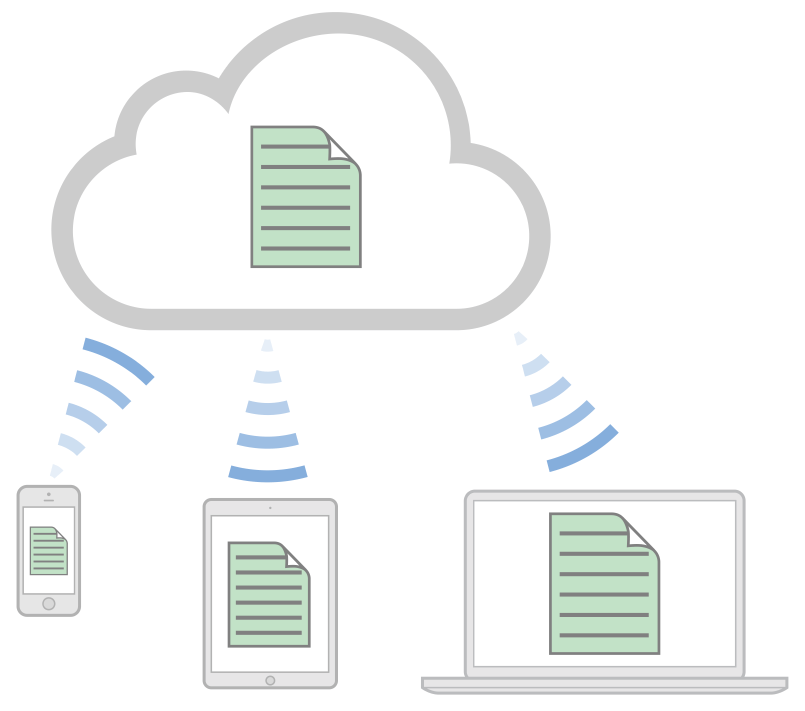iCloud is a free service that lets users access their personal content on all their devices—wirelessly and automatically via Apple ID. iCloud does this by combining network-based storage with dedicated APIs, supported by full integration with the operating system. Apple provides server infrastructure, backup, and user accounts, so you can focus on building great iCloud-enabled apps.

The core idea behind iCloud is to eliminate explicit synchronization between devices. A user never needs to think about syncing and your app never interacts directly with iCloud servers. When you adopt iCloud storage APIs as described in this document, changes appear automatically on all the devices attached to an iCloud account. Your users get safe, consistent, and transparent access to their personal content everywhere.
At a Glance
iCloud is all about content, so your integration effort focuses on the model layer of your app. Because instances of your app running on a user’s other devices can change the local app instance’s data model, you design your app to handle such changes. You might also need to modify the user interface for presenting iCloud-based files and information.
There is one important case for which Cocoa adopts iCloud for you. A document-based app for OS X v10.8 or later requires very little iCloud adoption work, thanks to the capabilities of the
NSDocument class.
There are many different ways you can use iCloud storage, and a variety of technologies available to access it. This document introduces all the iCloud storage APIs and offers guidance in how to design your app in the context of iCloud.
iCloud Supports User Workflows
Adopting iCloud in your app lets your users begin a workflow on one device and finish it on another.
Say you provide a podcast app. A commuter subscribes to a podcast on his iPhone and listens to the first twenty minutes on his way to work. At the office, he launches your app on his iPad. The episode automatically downloads and the play head advances to the point he was listening to.
Or say you provide a drawing app for iOS and OS X. In the morning, an architect creates some sketches on her iPad while visiting a client. On returning to her studio, she launches your app on her iMac. All the new sketches are already there, waiting to be opened and worked on.
To store state information for the podcast app in iCloud, you’d use iCloud key-value storage. To store the architectural drawings in iCloud, you’d use iCloud document storage.
Three Kinds of iCloud Storage
iCloud supports three kinds of storage. To pick the right one (or combination) for your app, make sure you understand the intent and capabilities of each. The three kinds of iCloud storage are:
- Key-value storage for discrete values, such as preferences, settings, and simple app state.
- Document storage for user-visible file-based information such as word processing documents, drawings, and complex app state.
- Core Data storage for shoebox-style apps and server-based, multi-device database solutions for structured content. iCloud Core Data storage is built on document storage and employs the same iCloud APIs.
Prepare for iCloud with Provisioning and Entitlements
The first two steps in adopting iCloud for your app are to obtain an appropriate provisioning profile for your development device and to request the appropriate entitlements in your Xcode project.
Entitlements are key-value pairs that request capabilities for your app—such as the capability to use iCloud. Your iCloud entitlement values define where your app can place data and they ensure that only your apps are allowed to access that data. You request separate entitlements for document storage and key-value storage. When you code sign your app, these requests become part of your app’s code signature.
How to Use This Document
Whether you are developing for iOS, OS X, or both, and no matter which sort of app you are developing, start by reading the entire “iCloud Fundamentals”chapter to get the foundation that all iCloud developers need.
Next, read “Designing for Key-Value Data in iCloud.” Any app that provides user settings or maintains user state—that is, nearly every app—should adopt iCloud key-value storage.
The iOS and OS X document architectures automatically provide most of the iCloud functionality needed by document-based apps. If your app works with file-based information, you’ll want to read “Designing for Documents in iCloud.”
If you are developing a Core Data app, read “Designing for Core Data in iCloud” for an overview of iCloud considerations for Core Data.
No matter which iCloud storage APIs you adopt in your app, testing is critical. To get started on creating a test plan for your app, read “Testing and Debugging Your iCloud App.”
See Also
This document describes the pieces you need to support iCloud in your app, but does not teach you how to develop apps. For that, start with Start Developing iOS Apps Today or Start Developing Mac Apps Today, and read the following documents:
- iOS apps: iOS App Programming Guide
- Mac apps: Mac App Programming Guide
If you plan to use Core Data with iCloud, learn about this technology in Core Data Programming Guide and be sure to read iCloud Programming Guide for Core Data.
For a tutorial introduction to implementing a document-based iCloud app for iOS, read Your Third iOS App: iCloud.
No comments:
Post a Comment